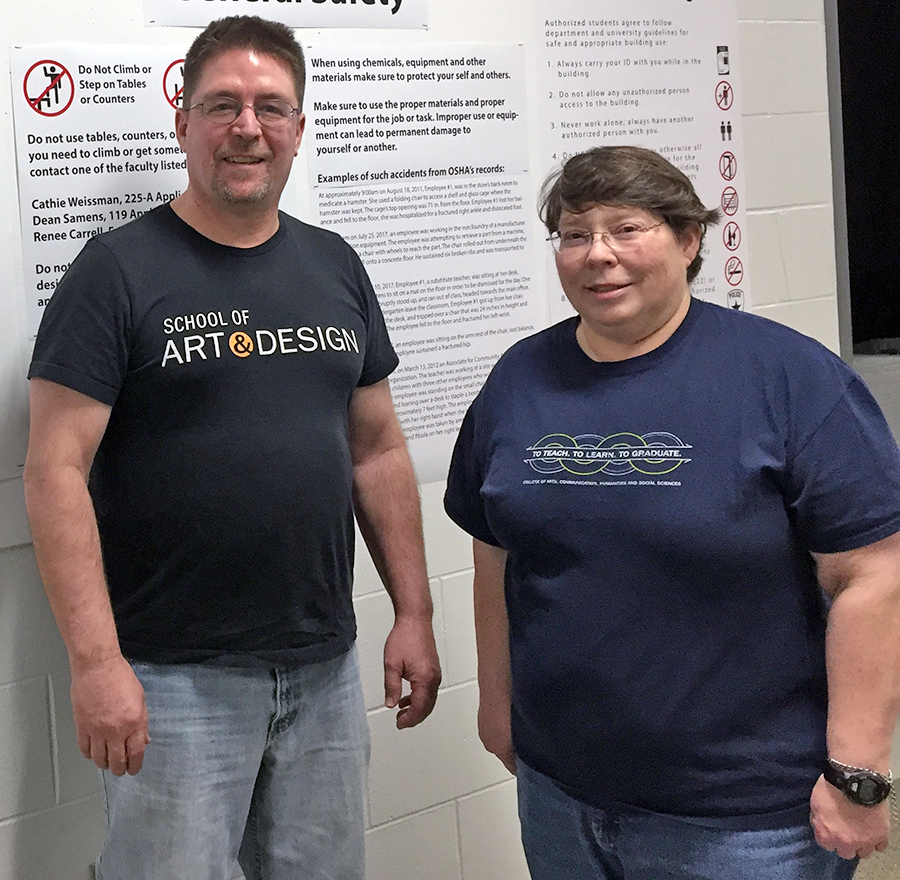Artists create beautiful paintings, drawings, sculptures, photographs, ceramics and more for others to enjoy or to provoke thought.
Yet the materials they use may contain chemicals or compressed gases, give off dust particles or are flammable. Those materials could impact their health and the health of others.
Two University of Wisconsin-Stout School of Art and Design staff attended a conference recently in Amherst, Mass., on the importance of using safety in artistic endeavors: Deano Samens, process lab coordinator, who oversees safe work practices in a wood and metals shop; and Cathie Weissman, financial specialist and the art and design safety coordinator.
The conference was led by industrial hygienist Monona Rossol, president and founder of Arts, Crafts and Theater Safety, Inc., a nonprofit corporation dedicated to providing health and safety services to the arts. She is also health and safety director for Local 829 of the United Scenic Artists, International Alliance of Theatrical Stage Employees. She taught the first course on art safety on record in 1980 at UW-Madison.
Samens and Weissman recently spoke on “Let’s Be Art – Smart! Health and Safety in the Art Studio” at UW-Stout. Their attendance at the conference was funded by Arts Integration Menomonie, a grant-funded program based out of the College of Education, Hospitality, Health and Human Sciences and the College of Arts, Communications, Humanities and Social Sciences.
 Tami Weiss, UW-Stout assistant professor of art education and executive director of AIM, said Weissman and Samens brought back important information. “They are truly passionate about supporting Stout’s emerging professional artists and art teachers who will model best and safe practice as they enter their careers,” Weiss said.
Tami Weiss, UW-Stout assistant professor of art education and executive director of AIM, said Weissman and Samens brought back important information. “They are truly passionate about supporting Stout’s emerging professional artists and art teachers who will model best and safe practice as they enter their careers,” Weiss said.
Weiss noted there are hazards surrounding labs and studio environments, including the materials and equipment used and the spaces themselves. “Our emerging artists and art teachers may not think about the storage of projects in the space above the cabinets as a fire hazard,” she noted. “In addition, there are specific storage and ventilation requirements and options in dealing with sprays and powders. Even the number of students in the classroom is a safety concern, above and beyond the issue of behavior management.
“AIM works with others to support teachers through the arts, and this safety conference is a perfect example of the commitment by the School of Art and Design to support our future art teachers in the School of Education. As a parent I want to send my children to an art teacher who will teach them a range of creative skill sets but only if I can trust that I’ll get my kids back with all body parts intact,” Weiss said.
UW-Stout ensures that students pass tests to use certain equipment in the process lab, which includes woodworking, plastics, metals and welding encompassing most projects by art and design students.

For children and any other artists, Weissman encourages reading material labels and following the safety suggestions, including the use of safety equipment or protective equipment such as smocks, gloves or goggles.
In particular, when using paints or other materials artists should use caution when around food or beverages. “Many art materials will not list truly what’s in their product because some materials are proprietary,” she noted. “Eating or drinking while working on art projects or doing artwork in the kitchen is not the best place.”
“It really is about raising awareness,” Samens said.
Some students will go on to teach art education and need to be aware of the potential harm if art materials are not used properly or art rooms don’t have adequate ventilation, he noted.
However, the concern is that artists don’t always think about the potential health risks with materials they are using.
Even some items not thought of as art materials may have health implications. For example, 3D printers can release nanoparticles that could be inhaled. Other materials may say nontoxic, but that could mean they have just not been tested, Samens said.
Weissman said education is key to make sure artwork is created safely and to protect the health of artists. “You want the person to go on making art as long as they can,” she said.
UW-Stout is Wisconsin’s Polytechnic University, with a focus on applied learning, collaboration with business and industry, and career outcomes.
###
Photos
UW-Stout process lab coordinator Deano Samens demonstrates safe practices in the process lab to art and design students. / UW-Stout photo by Pam Powers
Tami Weiss
Deano Samens, process lab coordinator, who oversees safe work practices in a wood and metals shop, and Cathie Weissman, financial specialist and the art and design safety coordinator, recently attended a conference on using safety in artistic endeavors.




